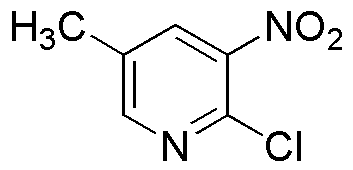2-Chloro-5-methyl-3-nitropyridine is widely utilized in research focused on:
- Pharmaceutical Development: This compound serves as an intermediate in the synthesis of various pharmaceuticals, particularly in the development of anti-inflammatory and antimicrobial agents.
- Agricultural Chemicals: It is used in the formulation of pesticides and herbicides, helping to enhance crop protection and yield by targeting specific pests and diseases.
- Material Science: The compound is explored in the development of advanced materials, including polymers and coatings, due to its unique chemical properties that can improve durability and resistance.
- Analytical Chemistry: It acts as a standard reference material in analytical methods, aiding researchers in the accurate quantification of similar compounds in various samples.
- Environmental Monitoring: This chemical is employed in studies assessing environmental pollutants, providing insights into the behavior and degradation of nitro-containing compounds in ecosystems.
General Information
Properties
Safety and Regulations
Applications
2-Chloro-5-methyl-3-nitropyridine is widely utilized in research focused on:
- Pharmaceutical Development: This compound serves as an intermediate in the synthesis of various pharmaceuticals, particularly in the development of anti-inflammatory and antimicrobial agents.
- Agricultural Chemicals: It is used in the formulation of pesticides and herbicides, helping to enhance crop protection and yield by targeting specific pests and diseases.
- Material Science: The compound is explored in the development of advanced materials, including polymers and coatings, due to its unique chemical properties that can improve durability and resistance.
- Analytical Chemistry: It acts as a standard reference material in analytical methods, aiding researchers in the accurate quantification of similar compounds in various samples.
- Environmental Monitoring: This chemical is employed in studies assessing environmental pollutants, providing insights into the behavior and degradation of nitro-containing compounds in ecosystems.
Documents
Safety Data Sheets (SDS)
The SDS provides comprehensive safety information on handling, storage, and disposal of the product.
Product Specification (PS)
The PS provides a comprehensive breakdown of the product’s properties, including chemical composition, physical state, purity, and storage requirements. It also details acceptable quality ranges and the product's intended applications.
Certificates of Analysis (COA)
Search for Certificates of Analysis (COA) by entering the products Lot Number. Lot and Batch Numbers can be found on a product’s label following the words ‘Lot’ or ‘Batch’.
*Catalog Number
*Lot Number
Certificates Of Origin (COO)
This COO confirms the country where the product was manufactured, and also details the materials and components used in it and whether it is derived from natural, synthetic, or other specific sources. This certificate may be required for customs, trade, and regulatory compliance.
*Catalog Number
*Lot Number
Safety Data Sheets (SDS)
The SDS provides comprehensive safety information on handling, storage, and disposal of the product.
DownloadProduct Specification (PS)
The PS provides a comprehensive breakdown of the product’s properties, including chemical composition, physical state, purity, and storage requirements. It also details acceptable quality ranges and the product's intended applications.
DownloadCertificates of Analysis (COA)
Search for Certificates of Analysis (COA) by entering the products Lot Number. Lot and Batch Numbers can be found on a product’s label following the words ‘Lot’ or ‘Batch’.
*Catalog Number
*Lot Number
Certificates Of Origin (COO)
This COO confirms the country where the product was manufactured, and also details the materials and components used in it and whether it is derived from natural, synthetic, or other specific sources. This certificate may be required for customs, trade, and regulatory compliance.


